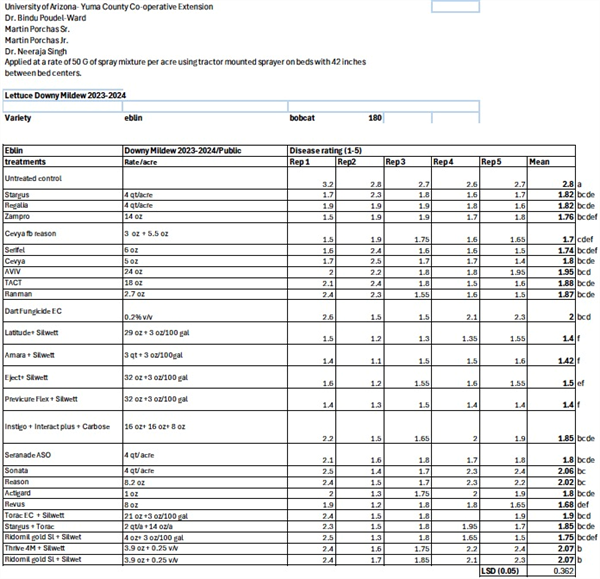Apr 5, 2017
Lettuce Crop Losses Workshop, Wednesday April 12
Next week the UA Vegetable IPM Team will be holding the 2017 Lettuce Insect, Disease and Weed Losses Workshop on Wednesday, April 12 beginning at 12:00 noon at the Yuma Agricultural Center (lunch is provided at no cost). Since 2004, we have annually surveyed PCAs and growers to document local pest activity and pesticide usage in Arizona lettuce through this interactive workshop. In my opinion, this is one of the more important meetings we hold each year. Not only do we gather your input on pest activity and pesticide use from this past produce season, but we also provide information on last year’s results and new information on vegetable IPM. This year we will discuss the light bagrada bug activity you experienced last fall and the local Diamondback moth outbreaks. The survey information provided by PCAs and growers during these workshops is very useful to the local produce industry. First, the data can be extremely helpful in addressing state and federal regulatory issues by providing “real world" information on insect pest status and insecticides usage. In the past data generated from the surveys has been used to support registrations of key insecticide products (i.e., Movento and Lannate) and is currently being used to support the re-registration of pyrethroids and imidacloprid. Secondly, from an academic perspective, the results of these surveys provide us with a historic record of pest occurrences and allows us to prioritize some of our research and educational activities. The insecticide usage data has also provided valuable support for many of the grant programs we request funding from. Finally, and perhaps most importantly for PCAs, it translates your efforts into economic terms for growers and shippers, and confirms the PCAs value to the lettuce industry by showing the importance of key pests and their cost-effective management in desert lettuce production. For example, survey results from the over the past 12 years show that on average, 1) costs associated with pest management fees have increased steadily where the cost of scouting and making management decisions by PCAs are well over $20/acre, 2) Leps, aphids and thrips are the most important economic pests in fall and spring lettuce, and 3) the use of older, broadly toxic insecticides (OP/Carbamates/Endosulfan) has dropped significantly, whereas use of the newer, softer reduced-risk chemistries (e.g., Radiant, imidacloprid, and diamides) continues to increase. Results from last year’s Crop loss surveys can be found in these two reports:
2015-16 Insecticide Usage on Desert Lettuce, 2015-16 and
Insect Losses and Management on Desert Lettuce: 2004‐2016 For the most part PCAs already know this, but these surveys document this information for those less involved with the day-to-day activities of IPM in desert lettuce. Hopefully PCAs and growers see the value in this process and will join us next week. The agenda for the meeting can be found here:
2017 Lettuce Insect, Disease and Weed Losses Workshop. Will be quizzing the audience – correct answers get a UA Veg IPM cap. See you there!
In response to the recent outbreaks of Diamondback moth (DBM) , Plutella xylostella in Yuma, we have established a pheromone trap network designed to monitor the activity and movement of adult populations of DBM. PCAs have had difficulty controlling DBM in cabbage, broccoli and cauliflower since October. Traps have been placed in Roll, Wellton, Dome Valley, Gila Valley and Yuma Valley in locations where cole crops are presently being grown or in areas where infestations were known to occur this fall.
To contact John Palumbo go to:
jpalumbo@ag.Arizona.edu

 In response to the recent outbreaks of Diamondback moth (DBM) , Plutella xylostella in Yuma, we have established a pheromone trap network designed to monitor the activity and movement of adult populations of DBM. PCAs have had difficulty controlling DBM in cabbage, broccoli and cauliflower since October. Traps have been placed in Roll, Wellton, Dome Valley, Gila Valley and Yuma Valley in locations where cole crops are presently being grown or in areas where infestations were known to occur this fall.To contact John Palumbo go to: jpalumbo@ag.Arizona.edu
In response to the recent outbreaks of Diamondback moth (DBM) , Plutella xylostella in Yuma, we have established a pheromone trap network designed to monitor the activity and movement of adult populations of DBM. PCAs have had difficulty controlling DBM in cabbage, broccoli and cauliflower since October. Traps have been placed in Roll, Wellton, Dome Valley, Gila Valley and Yuma Valley in locations where cole crops are presently being grown or in areas where infestations were known to occur this fall.To contact John Palumbo go to: jpalumbo@ag.Arizona.edu










